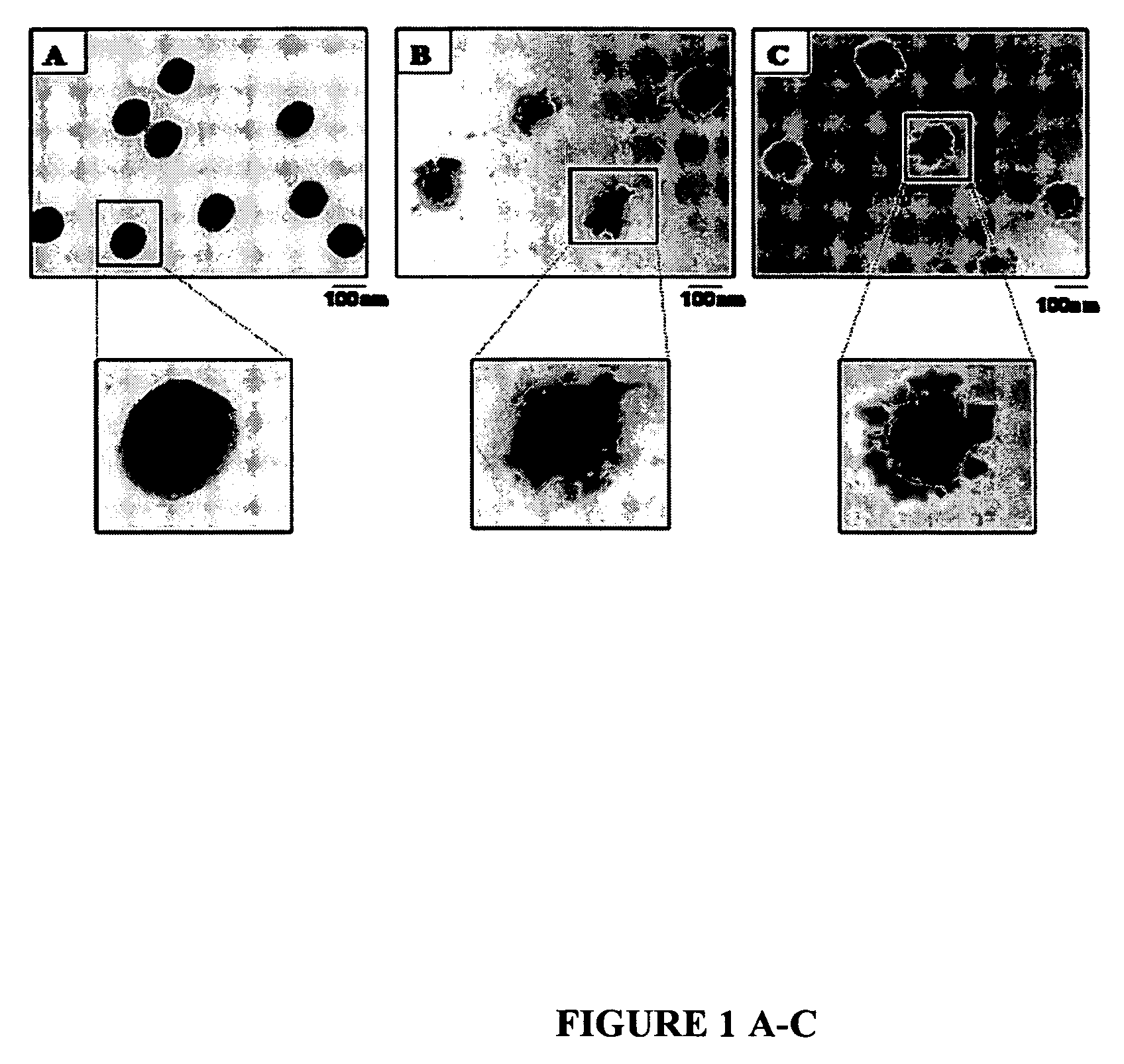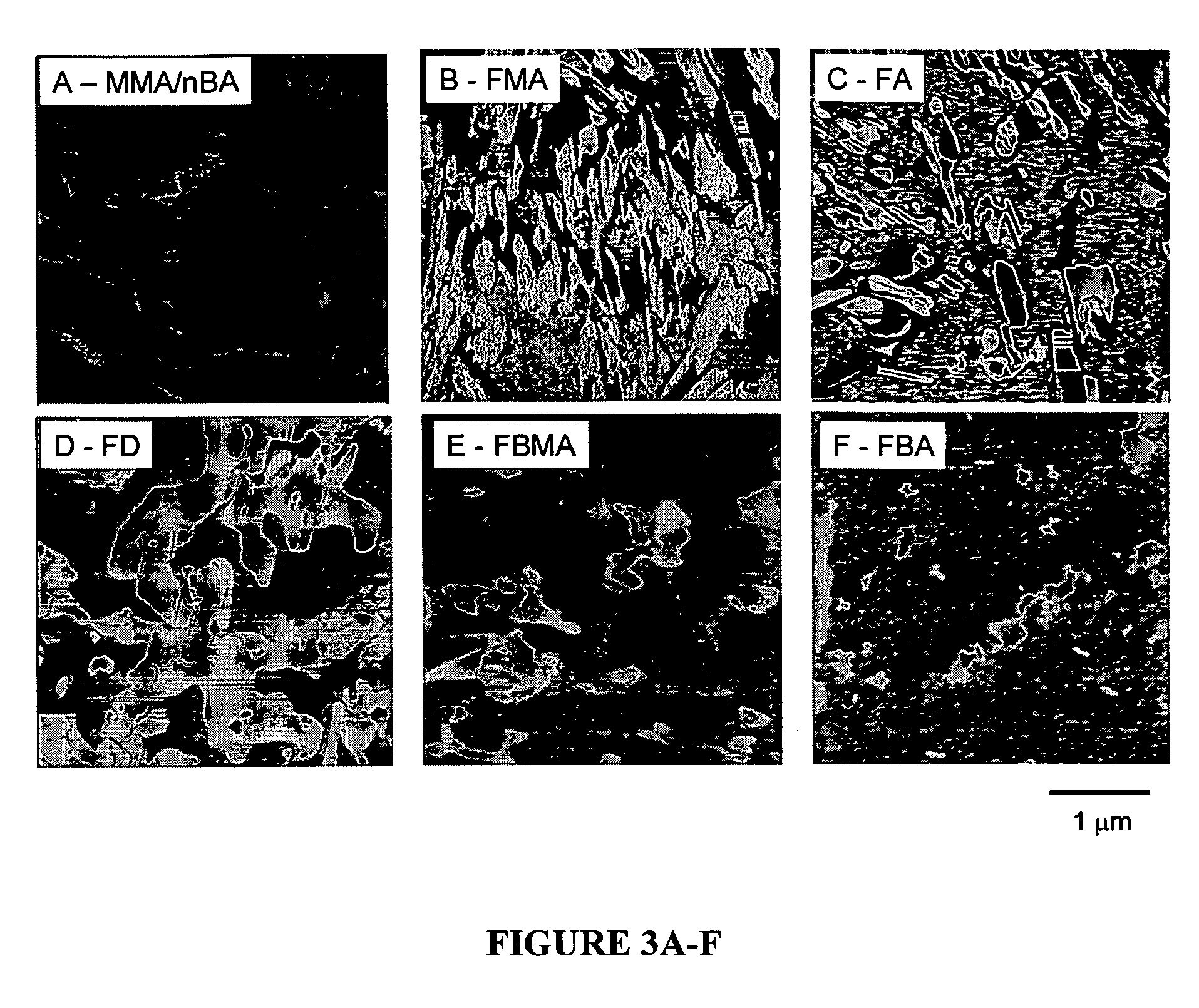Method for producing stable fluorine-containing water-dispersible latexes
a technology of water-dispersible latex and stable fluorine, which is applied in the direction of textiles, papermaking, coatings, etc., can solve the problems of difficult incorporation of colloidal particles, inability to achieve stable fluorine-containing latex, and inability to achieve desirable film properties
- Summary
- Abstract
- Description
- Claims
- Application Information
AI Technical Summary
Benefits of technology
Problems solved by technology
Method used
Image
Examples
example 1
[0012] T Methyl methacrylate (MMA), n-butyl acrylate (nBA), heptadecafluorodecyl methacrylate (FMA), potassium persulfate (KPS), and sodium dodecyl sulfate (SDS) were all purchased from Aldrich Chemical Co. Phosphoric acid bis(tridecafluoro-octyl) ester ammonium salt (FSP), was received from DuPont. The structures of SDS and FSP surfactants are shown below.
[0013] All colloidal dispersions were synthesized under monomer-starved conditions using a semi-continuous polymerization process in which all monomer and surfactants were dissolved in water and stirred under high agitation to produce a semi-stable pre-emulsion. 10% (w / w) of the pre-emulsion and 18% (w / w) of the initiator solution potassium persulfate were injected into the reaction kettle which contained 100 g of water. This process facilitates the seeding of the emulsion polymerization. The mixture was then stirred for 30 minutes to allow for initiation reactions to occur. The remaining pre-emulsion was fed continuously over 3...
example 2
[0018]FIGS. 1, A, B, and C illustrates transmission electron microscopy (TEM) micrographs of a series of p-MMA / nBA, P-MMA / nBA / FMA (FMA 8.5% w / w) and P-MMA / nBA / FMA (FMA 15% w / w) colloidal particles, respectively. As seen, p-MMA / nBA particles are spherical, whereas p-MMA / nBA / FMA exhibit more complex morphologies. As shown in FIG. 1, B, p-MMA / nBA / FMA particles 8.5% w / w FMA) are non-spherical with the high electron density areas due to p-FMA phase forming non-uniform shell around the p-MMA / nBA core. As the FMA content increases to 15% w / w, and DLPC phospholipids was utilized, the size of p-FMA phase attached to the exterior of the particles increase, giving multi-lobe morphologies. This is illustrated in FIG. 1, C.
[0019] The combination of DLPC with SDS / FSP surfactants results in the reduction of the overall surface tension of the aqueous phase from 72 mN / m to about 1-5 mN / m. These conditions appear to be essential during polymerization of the F-containing colloidal particles because l...
example 3
[0022] This example focuses on the development of colloidal particles containing methyl methacrylate (MMA), n-butyl acrylate (nBA), and a series of F-monomers. Specifically, the affect of the length of the CF2 tail on particle morphologies is studied as well as its effect on film formation, structure-property relationships, and surface macroscopic properties. For this experiment, we prepared methyl methacrylate / n-butyl acrylate (MMA / nBA) colloidal dispersions in the presence of 8.5% (w / w) copolymer content of heptadecafluorodecyl methacrylate (FMA), heptadecafluorodecyl acrylate (FA), heptadecafluoro-1-decene (FD), heptafluorobutyl acrylate (FBA), and heptafluorobutyl methacrylate (FBMA).
[0023] Methyl methacrylate (MMA), n-butyl acrylate (nBA), heptadecafluorodecyl methacrylate (FMA), heptadecafluorodecyl acrylate (FA), heptadecafluoro-1-decene (FD), heptafluorobutyl acrylate (FBA), heptafluorobutyl methacrylate (FBMA), potassium persulfate (KPS), phosphoric acid bis(tridecafluoro-...
PUM
| Property | Measurement | Unit |
|---|---|---|
| Fraction | aaaaa | aaaaa |
| Fraction | aaaaa | aaaaa |
| Fraction | aaaaa | aaaaa |
Abstract
Description
Claims
Application Information
 Login to View More
Login to View More - R&D
- Intellectual Property
- Life Sciences
- Materials
- Tech Scout
- Unparalleled Data Quality
- Higher Quality Content
- 60% Fewer Hallucinations
Browse by: Latest US Patents, China's latest patents, Technical Efficacy Thesaurus, Application Domain, Technology Topic, Popular Technical Reports.
© 2025 PatSnap. All rights reserved.Legal|Privacy policy|Modern Slavery Act Transparency Statement|Sitemap|About US| Contact US: help@patsnap.com



